The Auto Keratometer Market is estimated to be valued at USD 7.0 billion in 2025 and is projected to reach USD 12.1 billion by 2035, registering a compound annual growth rate (CAGR) of 5.6% over the forecast period.

The auto keratometer market is expanding steadily, driven by increasing demand for precise eye measurements in ophthalmology and optometry. The rising prevalence of refractive errors and age-related vision conditions has led to greater adoption of keratometers for accurate corneal curvature assessment.
Technological advancements have enhanced the portability, accuracy, and ease of use of these devices, making them integral in eye care diagnostics and treatment planning. The market growth is supported by the expansion of eye care infrastructure and rising awareness about vision health across diverse populations.
Furthermore, the increasing focus on early detection and correction of refractive errors, especially hyperopia, has boosted the use of auto keratometers in clinical settings. Hospitals continue to be a primary end user due to their comprehensive eye care services and high patient volumes. With ongoing innovations and growing demand for non-invasive diagnostic tools, the market outlook remains positive.
The market is segmented by Product Type, Application, and End Use and region. By Product Type, the market is divided into Handheld Auto Keratometer and Benchtop Auto Keratometer. In terms of Application, the market is classified into Hyperopia, Myopia, Astigmatism, and Other Ophthalmic Conditions. Based on End Use, the market is segmented into Hospitals, Clinics, Educational Institutes, and Diagnosis Centers. Regionally, the market is classified into North America, Latin America, Western Europe, Eastern Europe, Balkan & Baltic Countries, Russia & Belarus, Central Asia, East Asia, South Asia & Pacific, and the Middle East & Africa.
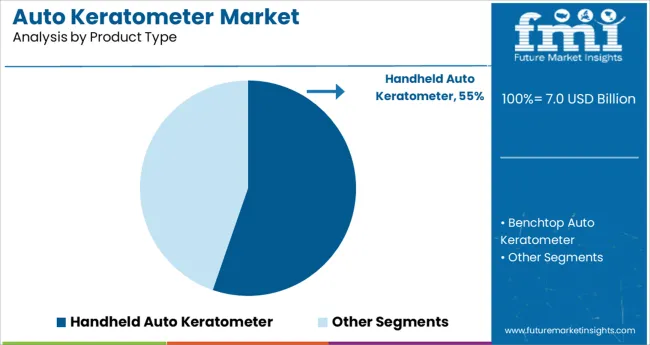
The handheld auto keratometer segment is expected to hold 55.3% of the market revenue in 2025, leading the product type category. This growth is due to the device's portability and ease of use, allowing eye care professionals to perform corneal measurements conveniently in varied clinical environments.
Handheld devices enable quick assessments in outpatient clinics, remote locations, and during patient bedside examinations. Their compact design and user-friendly interface have made them preferable in busy clinical settings where mobility and efficiency are essential.
The segment has benefited from improvements in optical sensors and digital displays, enhancing measurement accuracy. As demand grows for flexible diagnostic equipment, handheld auto keratometers are anticipated to maintain their market leadership.
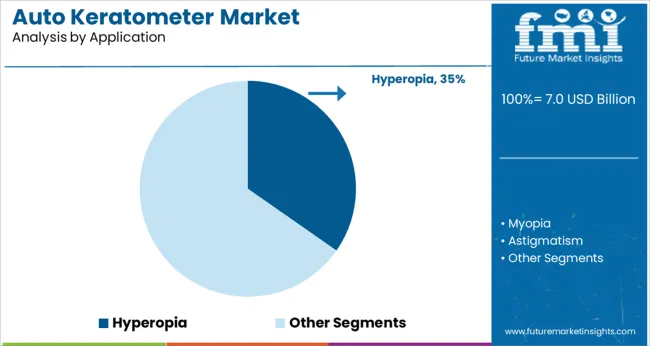
The hyperopia application segment is projected to account for 34.7% of the market revenue in 2025, marking it as a leading indication for auto keratometer use. The segment growth is attributed to the high incidence of farsightedness across all age groups, which requires precise corneal curvature measurements for effective diagnosis and corrective lens prescription.
Early detection of hyperopia is critical for preventing eye strain and other complications, increasing the reliance on keratometers in routine eye exams. Advances in diagnostic accuracy have improved patient outcomes and contributed to the segment's expansion.
Additionally, the segment benefits from increasing screening programs and vision care awareness that promote regular eye check-ups.
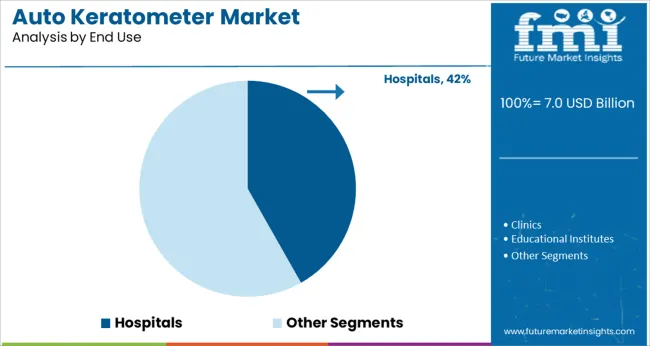
Hospitals are projected to represent 41.8% of the auto keratometer market revenue in 2025, holding the largest share among end users. The preference for hospitals arises from their capacity to deliver comprehensive ophthalmic care, including diagnosis, treatment, and surgical planning.
Hospital ophthalmology departments require precise and reliable keratometry data to manage refractive surgeries, cataract treatments, and other eye conditions effectively. The growing number of hospital-based eye care centers and integration of advanced diagnostic equipment have strengthened demand within this segment.
Additionally, hospitals’ ability to serve a large patient population with diverse ocular needs supports sustained growth. As vision care continues to evolve, hospitals are expected to remain a key market driver for auto keratometers.
Over the past couple of years, a significant rise in the prevalence of eye-related ailments and conditions, such as astigmatism, hyperopia, myopia, and others ophthalmic conditions, is being witnessed across the globe, resulting in augmenting the demand for eye diagnostics and treatment devices.
According to a study published by the World Health Organization, around 914.4 million people across the globe are suffering from presbyopia and unaddressed refractive error, collectively.
As auto keratometers are extensively used by ophthalmologists for a thorough diagnosis of the eye along with the measurement of refractor error degree, growing burden of such conditions is estimated to create lucrative growth opportunities in the global market.
Inaccurate measurement of corneal curvature of the eye might lead to complete imperfection in the curvature. In order to counter the parallax errors, medical spaces and personnel are increasingly adopting automated keratometry devices, which is in turn, creating strong demand for auto keratometers.
Hence, leading manufacturers in the market are emphasizing on research and development activities to launch novel keratometry devices integrated with innovative technologies and features. This is projected to accelerate the sales of auto keratometers in the market.
Although there are several advantages associated with the use of auto keratometers, extravagant cost of the device, need for qualified professionals to measure and calculate the readings, and the availability of relativity low-cost manual keratometers are factors hindering the sales in the market.
In addition to this, stringent regulatory standards and time-consuming new products approval processes by regulatory organizations such as the Food and Drug Administration, Central Drugs Standard Control Organization, and others are restraining the auto keratometer market growth.
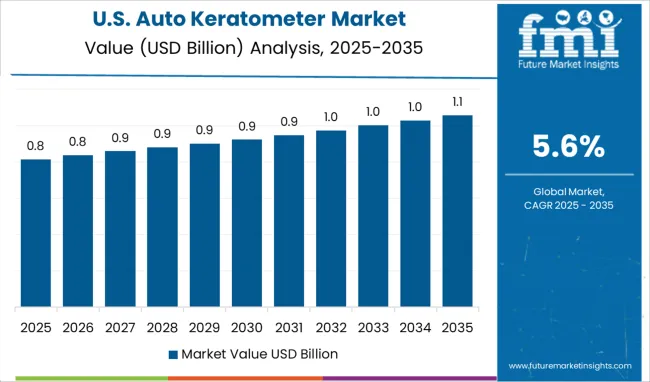
FMI states that North America is estimated to emerge as the most lucrative market for auto keratometers during the forecast period 2025-2035.
Burden of eye-related ailments is increasing at a rapid pace across North America, due to constantly use of smartphones, TV, and computer screens. According to a report by the American Academy of Ophthalmology, around 1 out of 3 individuals across the USA is suffering from astigmatism and nearly 150 million people in the country wears some corrective eyewear.
In addition to this, a swift rise in number of eye corneal refractive correction surgeries such as LASIK is being witnessed, owing to the growing patient inclination towards one-time procedures and presence of favorable reimbursement infrastructure.
As auto keratometers are extensively used for the determination of astigmatism along with the pre- & post-surgical assessment of cornea curvature, the increasing prevalence of astigmatism and growing corrective surgeries are projected to bolster the sales in the North America market.
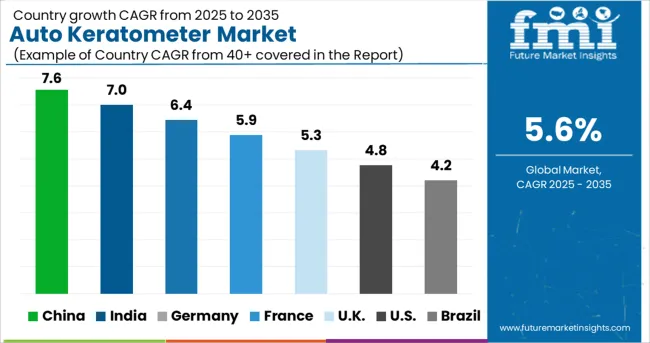
As per Future Market Insight, Japan is expected to account for a significant share in the global auto keratometer market between 2025 and 2035.
With increasing application of keratometry devices across hospitals, clinics, and diagnostics centers, driven by the growing patient pool of the eye-related conditions such as hyperopia, myopia, and presbyopia, demand for auto keratometers is rapidly surging.
Hence, key manufacturers in the market at aiming at introducing novel products with innovative features such as glare testing and auto-refractors to cater to this growing demand.
For instance, in 2020, NIDEK, a Japanese manufacturer of ophthalmic equipment announced launching its new automatic keratometer along with refractometer, 7.0 in touch display, and gentle voice guidance features. A slew of such development is anticipated to favor the growth in the Japan market.
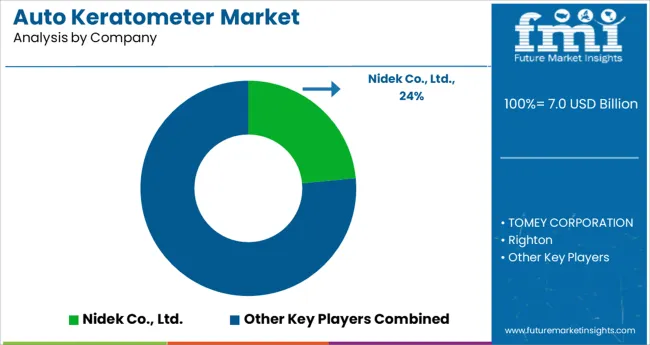
Some of the leading players in the auto keratometer market are Nidek Co., Ltd., TOMEY CORPORATION, Righton, GRAND SEIKO, Topcon Corporation, Potec, BON Optic, Coburn Technologies, Inc., Luneau Technology Group, and others.
Prominent players are focusing on improving the specifications and features of auto keratometers along with entering into partnerships, merges, and acquisitions for expanding their product portfolio.
| Report Attribute | Details |
|---|---|
| Growth Rate | CAGR of 4% to 5% from 2025 to 2035 |
| Base Year for Estimation | 2024 |
| Historical Data | 2020 to 2024 |
| Forecast Period | 2025 to 2035 |
| Quantitative Units | Revenue in million, Volume in Kilotons and CAGR from 2025 to 2035 |
| Report Coverage | Revenue Forecast, Volume Forecast, Company Ranking, Competitive Landscape, Growth Factors, Trends and Pricing Analysis |
| Segments Covered | Product Type, Application, End Use, Region |
| Countries Covered | North America; Latin America; Europe; CIS & Russia; APEJ; Japan; Middle East and Africa |
| Key Companies Profiled | Nidek Co., Ltd.; TOMEY CORPORATION; Righton; GRAND SEIKO; Topcon Corporation; Potec; BON Optic; Coburn Technologies, Inc.; Luneau Technology Group; Others |
| Customization | Available Upon Request |
The global auto keratometer market is estimated to be valued at USD 7.0 billion in 2025.
It is projected to reach USD 12.1 billion by 2035.
The market is expected to grow at a 5.6% CAGR between 2025 and 2035.
The key product types are handheld auto keratometer and benchtop auto keratometer.
hyperopia segment is expected to dominate with a 34.7% industry share in 2025.






Our Research Products

The "Full Research Suite" delivers actionable market intel, deep dives on markets or technologies, so clients act faster, cut risk, and unlock growth.

The Leaderboard benchmarks and ranks top vendors, classifying them as Established Leaders, Leading Challengers, or Disruptors & Challengers.

Locates where complements amplify value and substitutes erode it, forecasting net impact by horizon

We deliver granular, decision-grade intel: market sizing, 5-year forecasts, pricing, adoption, usage, revenue, and operational KPIs—plus competitor tracking, regulation, and value chains—across 60 countries broadly.

Spot the shifts before they hit your P&L. We track inflection points, adoption curves, pricing moves, and ecosystem plays to show where demand is heading, why it is changing, and what to do next across high-growth markets and disruptive tech

Real-time reads of user behavior. We track shifting priorities, perceptions of today’s and next-gen services, and provider experience, then pace how fast tech moves from trial to adoption, blending buyer, consumer, and channel inputs with social signals (#WhySwitch, #UX).

Partner with our analyst team to build a custom report designed around your business priorities. From analysing market trends to assessing competitors or crafting bespoke datasets, we tailor insights to your needs.
Supplier Intelligence
Discovery & Profiling
Capacity & Footprint
Performance & Risk
Compliance & Governance
Commercial Readiness
Who Supplies Whom
Scorecards & Shortlists
Playbooks & Docs
Category Intelligence
Definition & Scope
Demand & Use Cases
Cost Drivers
Market Structure
Supply Chain Map
Trade & Policy
Operating Norms
Deliverables
Buyer Intelligence
Account Basics
Spend & Scope
Procurement Model
Vendor Requirements
Terms & Policies
Entry Strategy
Pain Points & Triggers
Outputs
Pricing Analysis
Benchmarks
Trends
Should-Cost
Indexation
Landed Cost
Commercial Terms
Deliverables
Brand Analysis
Positioning & Value Prop
Share & Presence
Customer Evidence
Go-to-Market
Digital & Reputation
Compliance & Trust
KPIs & Gaps
Outputs
Full Research Suite comprises of:
Market outlook & trends analysis
Interviews & case studies
Strategic recommendations
Vendor profiles & capabilities analysis
5-year forecasts
8 regions and 60+ country-level data splits
Market segment data splits
12 months of continuous data updates
DELIVERED AS:
PDF EXCEL ONLINE
Autonomous Driving Simulation Tester Market Size and Share Forecast Outlook 2025 to 2035
Automotive Direct Liquid Cooling IGBT Module Market Size and Share Forecast Outlook 2025 to 2035
Automotive Hoses and Assemblies Market Size and Share Forecast Outlook 2025 to 2035
Automobile Brake Shoes Market Size and Share Forecast Outlook 2025 to 2035
Automotive Network Testing Market Size and Share Forecast Outlook 2025 to 2035
Automatic Chicken Deboning Machine Market Size and Share Forecast Outlook 2025 to 2035
Automated Radionuclide Dispenser Market Size and Share Forecast Outlook 2025 to 2035
Automotive Performance Part Market Size and Share Forecast Outlook 2025 to 2035
Automated Tool Grinding Systems Market Size and Share Forecast Outlook 2025 to 2035
Automatic Filter Press Solutions Market Size and Share Forecast Outlook 2025 to 2035
Automatic Filter Presses (AFPs) Market Size and Share Forecast Outlook 2025 to 2035
Automotive Carbon Ceramic Brake Market Size and Share Forecast Outlook 2025 to 2035
Automotive Camshaft Market Size and Share Forecast Outlook 2025 to 2035
Automotive Stamping Industry Analysis in India Size and Share Forecast Outlook 2025 to 2035
Automotive Cylinder Liner Market Size and Share Forecast Outlook 2025 to 2035
Automotive Microcontroller Market Size and Share Forecast Outlook 2025 to 2035
Autonomous Aerial Robot Market Size and Share Forecast Outlook 2025 to 2035
Automotive Roof Rails Market Size and Share Forecast Outlook 2025 to 2035
Automated Test Equipment Market Size and Share Forecast Outlook 2025 to 2035
Autoclave Market Forecast Outlook 2025 to 2035

Thank you!
You will receive an email from our Business Development Manager. Please be sure to check your SPAM/JUNK folder too.
Chat With
MaRIA